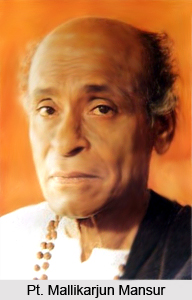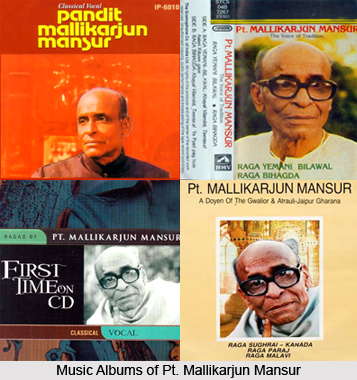 Pt. Mallikarjun Mansur was a classical singer from India, in Khayal style in the Jaipur-Atrauli gharana. Mallikarjun was born in Karnataka in the year 1910 in a musical and artistic family. He had an illustrious career, while maintaining a simple lifestyle. Mallikarjun Mansur has been bestowed with Padma Shri award in the year 1970, Padma Bhushan award in 1976 and the Padma Vibhushan in 1992.
Pt. Mallikarjun Mansur was a classical singer from India, in Khayal style in the Jaipur-Atrauli gharana. Mallikarjun was born in Karnataka in the year 1910 in a musical and artistic family. He had an illustrious career, while maintaining a simple lifestyle. Mallikarjun Mansur has been bestowed with Padma Shri award in the year 1970, Padma Bhushan award in 1976 and the Padma Vibhushan in 1992.
Early Life of Pt. Mallikarjun Mansur
Pt. Mallikarjun Mansur was born on 31 December 1910, in Manasoor village, in Dharwad, Karnataka. He was lucky to have been born into a family of performing arts and musicians. Encouraged by his father, Mallikarjun joined a travelling dance-and-drama troupe at a very early age. A Carnatic singer and violinist, Pundit Apayya Swami, who lived in the Dharwad area, initiated Mallikarjun into Carnatic music. During one of his performance, Mallikarjun was noticed by the illustrious classical Hindustani musician Nilakanthbua Alurmath, who advised his family to train him in music. After receiving permission from his family, Mallikarjun gladly followed him to Miraj where he trained under the Gwalior maestro for 6 years imbibing all the fundamental aspects of music
Mallikarjun was overjoyed by this proposal, and gladly followed him to Maihar, where the next few years were his most phenomenal stage in life, and he was transformed into an erudite singer. The upcoming years saw his rise and more rises in the success ladder, through his excellent performances in various musical styles and fashions. Despite all such kudos and his innate genius in renditions, he always maintained a humble and modest attitude to living, never yearning for stardom or flashy self-promotions. He ever remained a man of the village and dressed in a similar lamer, never hankering for city life and money. His years with his celestial guru, Manji Khan, son of Ustad Allauddin Khan were somewhat responsible for his code of conduct. When on stage, he would be completely engrossed in his rhythm and melodic combination and perform a song with such perfect ease and depth, that he could almost be named a perfectionist classical singer.
 Pt. Mallikarjun Mansur moved to Bombay (now Mumbai) and started giving concerts. He also cut a few records during the very early 1930s, which created quite an impact. He later trained under Ustad Alladiya Khan and then under Ustad Manji Khan, the elder son of Alladiya Khan of the Jaipur-Atrauli gharana. After the death of Ustad Manji Khan in 1937, Mallikarjun took training from Ustad Bhurji Khan, the younger son of Ustad Alladiya Khan.
Pt. Mallikarjun Mansur moved to Bombay (now Mumbai) and started giving concerts. He also cut a few records during the very early 1930s, which created quite an impact. He later trained under Ustad Alladiya Khan and then under Ustad Manji Khan, the elder son of Alladiya Khan of the Jaipur-Atrauli gharana. After the death of Ustad Manji Khan in 1937, Mallikarjun took training from Ustad Bhurji Khan, the younger son of Ustad Alladiya Khan.
Career of Pt. Mallikarjun Mansur
Pt. Mallikarjun Mansur had specialized in several ragas like Asa Jogiya, Shuddh Nat, Lachchhasakh, Khat, Hem Nat, Shivmat Bhairav, Sampoorna Malkauns, Bihari, Adambari Kedar, Lajawanti and Bahaduri Todi. His smooth and sweet voice, his full-throated voice production, devoid of nasality or gruffness and his incredible breath-control gave him a significant edge in singing the complex Jaipur gayaki fluently. After his successful musical performances during 1930s, HMV released his first album in 1935. Due to his expertise over most the conventional and non- conventional forms of the gharanas, Mallikarjun became widely popular and much appreciated during the 1950s.
Mallikarjun`s recorded music, which for the most part maintained a high standard, gave everybody a fairly reasonable idea about his style and approach. Being a dedicated and conscientious artist, he always sought to achieve the highest degree of perfection both in his recitals as also in his recordings. His rendition of Gaud Malhar, Bahaduri Todi, Jaunpuri, Bihagda, Shivmat Bhairav, Ramdasi Malhar, Nand, Yaman Kalyan, Lalita Gauri, Shree Nat Bihag, Sampurna Malkauns and Maru Bihag are outstanding.
Publications of Pt. Mallikarjun Mansur
Pt. Mallikarjun Mansur had written an autobiography named Nanna Rasayatre in Kannada, which was translated into English, titled My Journey in Music. The translation was done by Rajshekhar Mansur, his son.
Personal Life of Pt. Mallikarjun Mansur
Pt. Mallikarjun Mansur married Gangamma and the couple had a son, Rajashekhar Mansur, and 7 daughters. His daughter, Neela Kodli, and his son, Rajashekhar Mansur, are vocalists.
Death of Pt. Mallikarjun Mansur
Pt. Mallikarjun Mansur died on 12th September 1992, at the age of 81.
Mallikarjun Mansoor left behind no known disciples worthy of taking up his mantle. His standards were lofty and his demands exacting for even the brilliant student of music. He expected nothing short of total dedication and all-consuming passion for the art from those that wanted to be disciples. His expectations from them were no different from what he expected of himself.




















